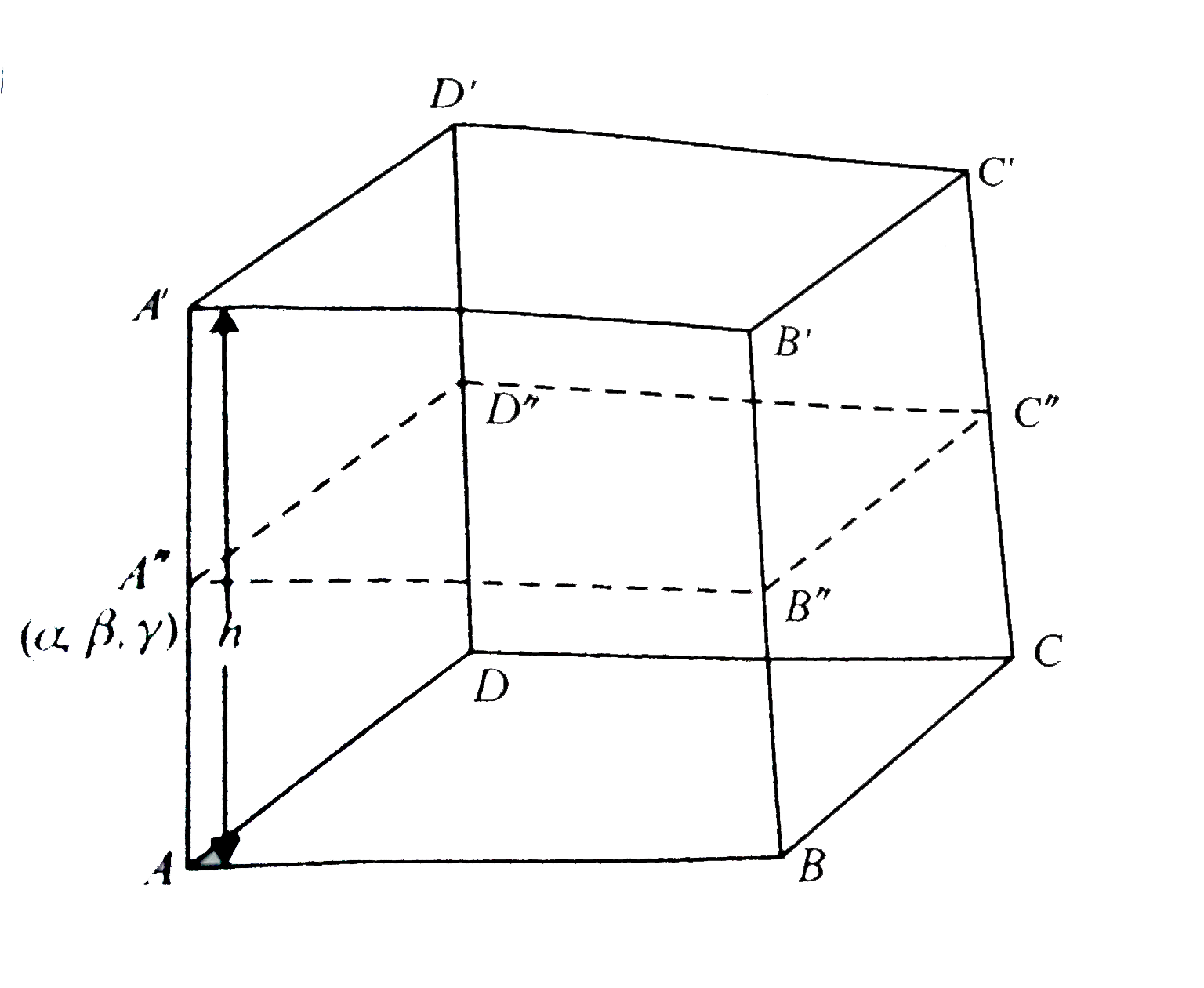A parallelepiped S has base points A,B,CandD and upper face points A′,B′,C′,andD' . The parallelepiped is compressed by upper face A'B'C'D' to form a new parallepiped T having upper face points A,B,Ca n dD . The volume of parallelepiped T is 90 percent of the volume of parallelepiped S. Prove that the locus of A is a plane.
S is the parallelepiped with base point A,B,CandD and upper face points A',B',C'andD'. Let its volume ve Vs. By compressing it by upper face A',B',C'andD', a new parallelepiped T is formed whose upper face points are now A'',B'',C''andD''. Let its volume be VT.
Let h be the height of original parallelepiped S. Then
VS=(area of ABCD)×h (i)
Let equation of plane ABCD be ax+by+cz+d=0andA''(α,β,γ).

Then the height of the new parallelepiped T is the length of the perpendicular from A'' to ABCD, i.e., aα+η+cγ+d√a2+b2+c2. Therefore
VT=(ar ABCD)×(aα+η+cγ+d)√a2+b2+c2 (ii)
But given that VT=90100Vs (iii)
From (i), (ii) and (iii), we get
aα+η+cγ+d√a2+b2+c2=0.9h
or aα+η+cγ+d−0.9h√a2+b2+c2=0
Therefore, the locus of A''(α,β,γ) is ax+by+cz+d−0.9h√a2+b2+c2=0, which is a plane parallel to ABCD. Hence proved.
Topper's Solved these Questions
- BOOK - CENGAGECHAPTER - THREE-DIMENSIONAL GEOMETRY EXERCISE - Exercise (Numerical)10videos
THREE-DIMENSIONAL GEOMETRY
- BOOK - CENGAGECHAPTER - THREE DIMENSIONAL GEOMETRYEXERCISE - Question Bank20videos
THREE DIMENSIONAL GEOMETRY
- BOOK - CENGAGECHAPTER - TRIGNOMETRIC RATIOS IDENTITIES AND TRIGNOMETRIC EQUATIONSEXERCISE - Question Bank34videos
TRIGNOMETRIC RATIOS IDENTITIES AND TRIGNOMETRIC EQUATIONS
Similar Questions
T is a parallelepiped in which A,B,C and D are vertices of one face and the face just above it has corresponding vertices A’,B’,C’,D’,T is now compressed to S with face ABCD remaining same and shifted to A”,B”,C”,D”, in S. The volume of parallelepiped S is reduced to 90% of T. Prove that locus of is a plane.
View SolutionVolume of parallelepiped formed by vectors →a×→b,→b×→c and →c×→a is 36 then find the volume of parallelepiped formed by the vectors →a,→b and →c
View Solution
Knowledge Check
- Question 1 - Select One
A parallelepiped is formed by planes drawn parallel to coordinate axes through the points A=(1,2,3) and B=(9,8,5). The volume of that parallelepiped is equal to (in cubic units)
A192B48C32D96
Using determinants prove that the points (a, b), (a′, b′)and (a−a′, b−b′) are collinear if ab′=a′b.
View SolutionA parallelepiped is formed by planes drawn through the points (2,3,5)and(5,9,7) , parallel to the coordinate planes. The length of a diagonal of the parallelepiped is a.7 unit b. √38 unit c. √155 unit d. none of these
View SolutionThe volume of he parallelepiped whose sides are given by →OA=2i−2,j,→OB=i+j−kand→OC=3i−k is a.413 b. 4 c. 27 d. 2
View SolutionFind the altitude of a parallelepiped whose three coterminous edtges are vectors →A=ˆi+ˆj+ˆk,→B=2ˆi+4ˆj−ˆkand→C=ˆi+ˆj+3ˆkwith→Aand→B as the sides of the base of the parallepiped.
View SolutionThe volume of a tetrahedron formed by the coterminous edges →a,→b,and→c is 3. Then the volume of the parallelepiped formed by the coterminous edges →a+→b,→b+→cand→c+→a is 6 b. 18 c. 36 d. 9
View SolutionTwo circles with centres AandB of radii 3cmand4cm respectively intersect at two points CandD such that ACandBC are tangents to the two circles. Find the length of the common chord CD.
View SolutionTwo dice are rolled, write the sample space 'S' and number of sampkle points n(S). Also write events and number of sample points in the event according to the given condition
Sum of the digits on upper face is a prime numberView Solution

